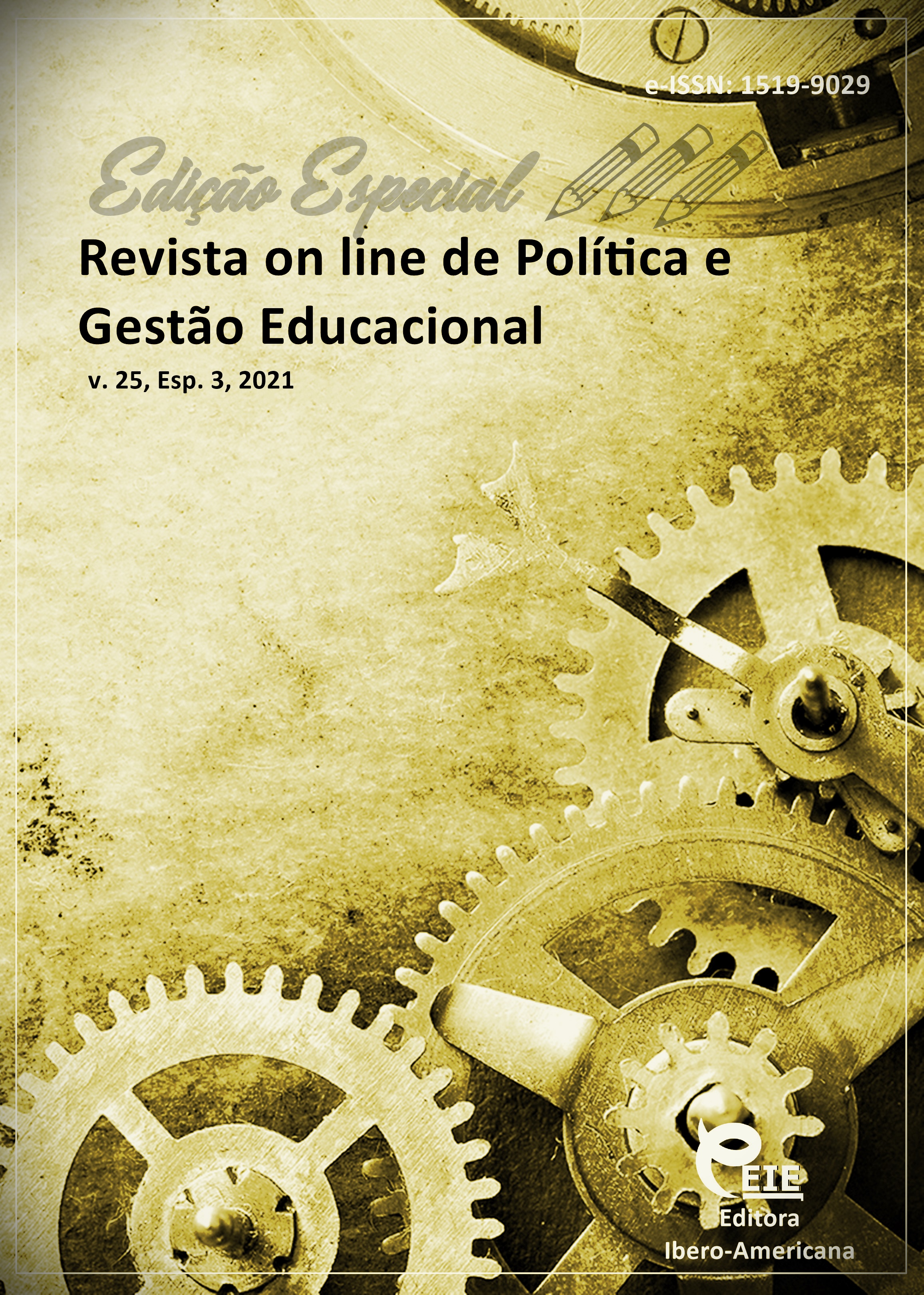Prospects for the application of active learning methods in modern education
DOI:
https://doi.org/10.22633/rpge.v25iesp.3.15587Keywords:
Modern education, Active learning methods, Innovative approaches, Prospects of applicationAbstract
The article examines the prospects for the application of active learning methods in modern education. The survey shows that the prospects for the application of active learning methods in modern education are conditioned by the influence of different factors. These factors can be divided into several groups: comprehensive organization of teaching, building adequate communication, the use of new learning technologies, organization of personality-oriented education and teamwork. The survey showed that there are real and potential barriers for teachers to use innovative teaching methods, but there is no serious paradox. There is no doubt that there is an intensive interest in the prospects and future of the application of active learning methods in modern education and their application in education. When choosing a teaching method, teachers' ability to use this method and local conditions should be considered.
Downloads
References
ALIYEV, B.; JABBAROV R. The problem of personality in education.Baku, Educa¬tion, 2008, 136 p. Available: https://lsu.edu.az/new/LSU-Library/l¬b/Stud¬ent_¬/psyc¬holo¬gy.¬php
APEL, H. J. Predavanje, uvod u akademski oblik poucavanja, Zagreb: EruditA,2003. Available: https:¬//libra¬ry.foi.hr/lib/¬knjiga¬.php?B=2¬0&H=&E¬=&V=Y¬&lok
ASTİN, A.W. What matters in college? Four critical years revisited. Jossey-Bass.1993 Available: https://psycnet.apa.org/record/1992-98891-000
AKMHETOVA, G.K. System of Professional Development of Pedagogical Staff in the Republic of Kazakhstan: Update Strategy.Almaty:University of Kazakhstan, 2016, 90 p.
AKSARİN, S. Investigation of the problems of innovative pedagogical activity in the modern vocational education system. Yugorsk State University Bulletin, V.1 (36), p.17-19, 2015. Available: https://cyberleninka.ru/article/n/issledovanie-problem-innova¬tsion¬noy
BEİCHNER, R. J. History and Evolution of Active Learning Spaces. New Directions for Teaching and Learning, 2014, 9-16. Available: http:¬//¬dx.doi.org/10.1002/tl.20081
BOEKAERTS, M.; MUSSO, M.; CASCALLAR, E. Self-Regulated Learning and the Understanding of Complex Outcomes. Educational Psychology International, 2012, 1-81. http://dx.doi.org/10.1155/2012/686385
BONÜELL, C. C.; EİSON, J. A. Active learning: Creating Excitement in the Classroom. ASHE-ERIC, Higher Education Report n. 1.1991, Washington, DC: George Washington University. Available: https://eric.ed.gov/?id=ED336049
BROCKLİSS, L. Curricula. A History of the University in Europe. Cambridge (Reino Unido): Cambridge University Press,1996, Vol. 2., pp.565-620. Available: https:/¬/www-.scirp¬org/(¬S(351jm¬bntv nsjt1aadkp oszje)) /refer ence/Re ferences Paper s.aspx ?ReferenceID=1542008
CLOVİS, L.K.; MARTHA B.A.; PEDRO H.M. Active Teaching and Learning Meth-odologies: Some Considerations, Creative Education, 2015, 6, 1536-1545. Available: http://www¬.scirp.org/ journal /cehttp://d x.doi .org/1 0.423 6/ce.20 15.6 14154
DOYLE, T. Helping Students Learn in a Learner-Centered Envi¬ronment: A Guide to Facilitating Learning in HigherEducation. Sterling, VA: Stylus Publishing. 2008. Available: https://www.¬scirp.org/(S¬(i43dyn45¬teexjx455qlt¬3d2q))/r¬efer¬encaspx?ReferenceID=1542011
FELDER, R.M.; BRENT R. “Learning by Doing.” Chem. Engr.Educ¬ation,2003, 37(4),282-283. Available: https://¬www.¬eng r.ncsu.edu/wp-content/u¬ploads/d¬rive/1¬XaOo9¬WCK¬cMq6-fTcQG¬idOT2¬SDGq¬g70l5/2009-ALpaper(ASQ).pdf
FREEMAN, S.; EDDY, S. L.; MCDONOUGH, M.; SMİT, M. K.; OKOROAFOR, N.; JORDT, H.; WENDEROTH, M. P. Active Learning Increases Students’ Performance in Science, Engineering, and Mathematics. Proceedings of the National Academy of Sciences of the United States of America, 2014, 111, 8410-8415. Available: http://¬www.¬pnas.¬org/-cont¬ent/111/23/8410.full.pdf
HAKE, R. R. Interactive-Engagement vs. Traditional Methods: A Six-Thousand-Student Survey of Mechanics Test. Data for Introductory Physics Courses. American Journal of Physics, 1998, 66, 64. Available: http://dx.doi.org/10.1119/1.18809
HALPERN, D. F.; HAKEL, M. D. Applying the Science of Learning to the University and Beyond: Teaching for Long-Term Retention and Transfer. Change, 2003, 35, 36-41. Available: http://dx.doi.org/10.1080/00091380309604109
INMACULADA C.; MARİA A.; ESTER T. Motivation for the academic reading of future tea¬chers. Educação & Formação Educ. Form., Fortaleza, 2021, v. 6, n. 1, e3535. DOI: https://d¬oi.org/1¬0.25053¬/reduf¬or.v6i1¬.3535
JUNGES, F.C.; KETZER, C. M.; OLİVERA, V. M. Continued teacher training: Ressignficated knowledge and transformed teaching practices. Educação & Formação, Fortaleza, v.3, n.9, p. 88-101, set./dez. 2018. DOI: https:¬//doi.org¬/10.2505¬3/redu¬for.
KRASNOV, S.I. Norms of social design and simulation of innovation. Problems of design in the work of graduate students of OR RAO for 1994 – 1995. Available: ¬https:/¬/cyber¬leni-nka.¬ru/arti¬cle¬/n/instrumentariy-institutsionalnogo-modelirovaniya.
LUCKESİ, C. C. Assessment of school learning: paths taken. Doctoral thesis. Graduate Program in Philosophy of Education. PUC-SP, 1994. Available: http://w¬ww.¬lef¬fa.pro¬.br/te-la4/T¬extos¬
MOCİNİC, S. N. Active teaching strategies in higher education. Metodicki obzori ,2012, 15, vol. 7; 2. DOI: https:/¬¬/doi.org/¬10.32728/mo.07.2.2012.08
MOHAMMED O.; SEİD D.; ABDURAHMAN T. The Practice and Prospects of Active Learning Methods in Wollo University, American Scientific Research Journal for Engi-neer¬ing, Technology, and Scie¬nces, 2020, Volume 65, No 1, pp 1-15.
NAZAROV, A. Modern learning technologies. Textbook. ADPU-publishing house. Baku: 2012, 103 p. Available: http://anl.az/el/Kitab/Azf-269214.pdf
PRİNCE M. J. Does Active Learning Work? A Review of the Research. Journal of Engineering Education,2004, 93, 223-231. Available: http://d¬x.doi.¬org/10.¬1002/¬j.2168-9830-0¬809.x
ROÜE, M. B. Pausing Principles and Their Effects on Reasoning in Science. In F. B. Brawer (Ed.), Teaching the Sciences: New Directions for Community Colleges, 1980, pp. 27-34. San Francisco: Jossey-Bass. Available: http://dx.doi.org/10.1002/cc.36819803106
STİENER-HAMSEY, G. How NGOs react: globalization and education reform in the Caucasus, Central Asia and Mongolia. Kumarskaya press, v.31 (2), p.25-36, 2018. DOI: 10.1111 / j. 1467-873X.2008.00426.x.
TAGUNOVA, I.A.; SELİVANOVA, N.L.; VLEEVA, R.A. The category of upbringing in Russian and western studies. Mathematics Education, V.11(1), p.3-9, 2016. DOI: 10.12973/i ser.201 6.2101a.
ZANCHİN, M. R. Le strategie attive, u AA.VV., Le interazioni educative, Roma: Armando, 2002.
Published
How to Cite
Issue
Section
License
Copyright (c) 2021 Revista on line de Política e Gestão Educacional

This work is licensed under a Creative Commons Attribution-NonCommercial-ShareAlike 4.0 International License.
Manuscritos aceitos e publicados são de propriedade da Revista on line de Política e Gestão Educacional. É vedada a submissão integral ou parcial do manuscrito a qualquer outro periódico. A responsabilidade do conteúdo dos artigos é exclusiva dos autores. É vedada a tradução para outro idioma sem a autorização escrita do Editor ouvida a Comissão Editorial Científica.










